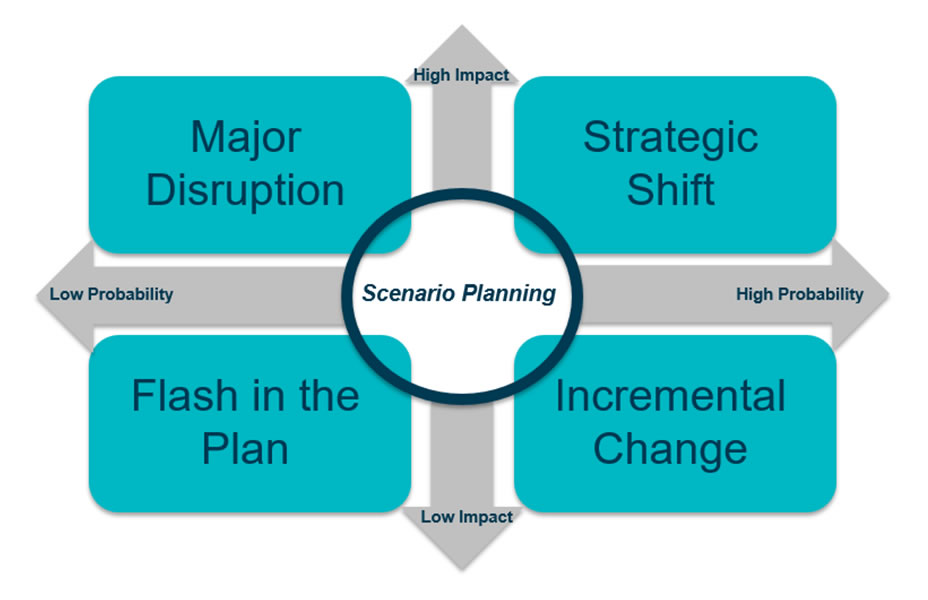Lessons from the Pandemic: The Value of Scenario Planning
By Suzanne Tan, Senior Consultant – Executive Leadership and Transition Management (Nonprofit)
If nothing else, the past 18 months have demonstrated the need to prepare for the unknown. But how is that possible? Scenario planning has been widely discussed as a tool to prepare for an uncertain future — but for many, the details of this practice remain ambiguous. In our Nonprofit and Social Sector practice focused on executive search, transition management, and strategic planning (as well as the intersection of these opportunities) we’ve noticed a new wave of organizations reaching out for support, not just to address existing issues but also in anticipation of what’s to come.
Increasingly, people recognize the importance of proactive planning for inevitable leadership transitions throughout every level of an organization. We continue to see many long-tenured executives leaving their positions and/or retiring early. Instead of rushing headlong into a search process, board members and organizational leaders are appreciating the inherent opportunities following a leadership departure to reimagine the organization’s future. They are also adopting new priorities that leverage their strengths and advance their relevancy. These organizational dynamics lend themselves well to the exercise of scenario planning.
Scenario Planning: Why Now?
The pandemic made all of us more aware of aspects of our work and our lives that need to be changed or discontinued altogether. Scenario planning can help broaden your field of awareness and build resilience and confidence. The tools and insights gained through this practice can serve as a valuable guide when faced with an unknown future.
Based on our collective experiences in the past year and a half, it’s easy to see the benefits of sharpening our ability to anticipate potential scenarios and corresponding pivots.
How does scenario planning work?
A preparedness tool to gain reassurance amid uncertainty, scenario planning is comprised of “what if” considerations about how the future might unfold. The exercise is designed to challenge conventional assumptions.
This type of futurist planning is a useful component of strategic planning and can help key stakeholders, such as an organization’s board of directors, staff, and key community partners, develop an inclusive, shared organizational vision. Scenario planning can also build understanding between people across an organization, clarify organizational values, and contribute to a stronger, more cohesive internal culture. Scenario planning encourages creativity and imagination and recognizes the value of agility in decision-making.
To begin a classic four-scenario exercise, identify external opportunities and challenges (i.e., an angel investor makes a large gift or a natural disaster affects the region). Next, identify internal factors (i.e., significant leadership turnover or failing technology) that could come into play. Then map these outcomes according to high/low probability and high/low impact. A combination of external and internal drivers will be included in every potential scenario. (See diagram below.)

The high probability/high impact scenario will require a strategic shift. What if a natural disaster occurs (which is increasingly likely across the country at some point), and mission delivery is brought to a sudden stop? What backup plans do you need for this inevitability? For example, perhaps you should build stronger partnerships with similar organizations in case you ever need to temporarily consolidate services. Naming this possibility and exploring courses of action is critical to developing organizational awareness and resilience.
A high probability/low impact scenario necessitates an incremental change — an important area to address but one that will play out over time. Perhaps the organization’s largest donor decides to wind down their giving within the next three years. That requires a focus on diversifying revenue in an organization that hasn’t prioritized development. This scenario gives the organization time to bring in the resources it needs and put into place strategies to broaden its donor base in anticipation of this certainty.
A low probability/high impact scenario represents a major disruption. Although some say that we could have seen it coming, COVID-19 falls squarely in this quadrant, with a lack of preparation to transition to a remote workforce as an internal factor. If we had brainstormed our responses to a global pandemic (or an analogous scenario) before one occurred, we would have put into place policies and procedures to support remote operations at a moment’s notice, similar to an evacuation plan in case of fire.
Lastly, a low probability/low impact scenario is aptly named a “flash in the pan.” What if the organization’s largest annual fundraiser falls far short of expectations, bringing in just a fraction of the expected revenue? If reserves have been set aside, the organization can temporarily recoup its losses — but what would this mean for future planning? Recovering from the shock and embarrassment of such a weak return would be the least of the organization’s concerns. This scenario would convey the importance of relevant and compelling engagement strategies that are well-planned, inclusive, accessible, and mission-centric. Perhaps the failed event model is outmoded and didn’t resonate because audience demographics and/or socio-political forces irrevocably shifted.
In summary, this overview offers a methodology for organizations to engage in brainstorming sessions that address the implications of certain scenarios, however likely or unlikely they are, and the potential courses of action. Even if a scenario seems implausible, the exercise of naming these prospects and formulating viable responses builds internal resilience and insight in the event of something inevitable or wholly unexpected and fosters confidence in the organization’s ability to move forward no matter what happens.
The concept of scenario planning can be extended to every part of our lives as a tool to prevent stasis and complacency and explore the possibilities, objectively and without attachment, and yes, prepare for the unknown. As we try to make sense of the world around us and keep pace with the ever-changing dynamics and expectations of our sector, the adaptive and iterative process of scenario planning supports an imaginative mindset of curiosity and wonder that underscores the resilience and optimism necessary to navigate our post-pandemic world.




















